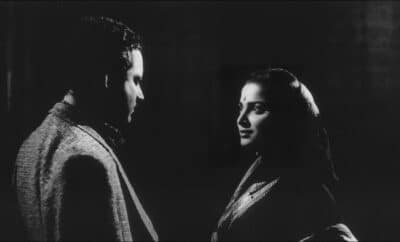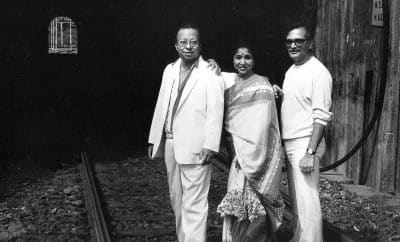Song Sketch
O Panchhi Pyaare – Bandini – Vain Longing for Freedom
We all keep on craving for freedom in life, without realising that we are already on a life sentence, imprisoned in the material world for the wrongs that we have committed in the past life, perhaps! Oblivious to this, most of us keep on repeating our mistakes even during the current sentence, just like a dog returning to his vomit, and are sentenced to the next life. However, those who realise this avoid repeating the mistakes and are eventually set free from the repetitive imprisonment life after life, as our spiritual philosophy believes.
Kalyani (Nutan), an innocent and righteous rural girl in Bandini (1963), who has landed in a jail after being forced by unfavourable circumstances to commit a murder, realises this, and gets an early release from the jail owing to her good behaviour during the sentence.
Initially, on her arrival in the prison, while she is devastated, she is taken aback to see that almost all her inmates have accepted the prison as their world and perfectly acclimatised themselves to it. While completing the tasks assigned to them, they rejoice, cry, share the joys and sorrows and quarrel with each other, as though that is the only world ever known to them. When the inmates are in a good mood or are feeling low, they occasionally express their feelings through songs.
Another morning – pleasant, yet with a tad of sullenness outlined by the boundaries of the prison, and all the inmates are busy in their daily chores. A cuckoo cuckooing somewhere elicits memories of the almost forgotten outside world in the mind of one of Kalyani’s inmates, and her mind is flooded with a mixture of sweet and sour feelings. The spring of her emotions starts flowing in the form of a couplet –
Do nainan se milan ko do naina akulaayen,
Jab naina ho saamne, to naina jhuk jaayen…
My eyes are eager to meet the eyes of my lover. But whenever I actually face the lover, I can’t raise my eyes to see him. What an ironical dilemma!
Through these lines, the inmate actually describes the love between Kalyani and the prison doctor Devendra (Dharmendra), that is silently and slowly budding, and Kalyani’s dilemma about the love.
After a sweet piece of flute, the song starts with mixed percussion comprising winnowing sound, dholak, triangle and temple blocks, perfectly indicating various activities being carried out by the prisoners on screen. The inmate now sees through the window, a bird freely flying from tree to tree, and asks it an innocent question –
O panchhi pyaare, saanjh sakaare,
Bole tu kaunsi boli, bata re, bole tu kaunsi boli?
O lovely bird, which is this delightful tongue in which you keep chirping sweetly throughout the day? Perhaps, the saccharinity of your tongue has its roots in your freedom!
While singing these lines, the focus shifts to the singing inmate. She is singing while stitching something, as though she is trying to seam her torn fate through it.
The first interlude then follows again with percussion in the form of winnowing sound accompanied by dholak, triangle and temple blocks, and catchy pieces of flute, and the prisoner gives way to the pang in her heart, the smile on her face gradually waning –
Main to panchhi, pinjre ki maina, pankh mere bekaar,
Beech hamaare saat re saagar, kaise chaloon us paar?
I am a caged mynah, and my wings are as useless as they could be. The distance between us is too vast, as if there are seven seas between us. How would I cross them with my tiny winy wings and the lost confidence?
The initially light-hearted song now unwinds into a tint of pathos. The camera zooms in, and we see the inmate with a poignant face behind seven bars that divide her and the outside world, which seem as impossible to cross as seven seas to the poor lady. We also get to see a cute little bird on a tree outside, on the background of the prison, brilliantly portraying the two contrasting worlds in a single frame.
Then comes a flute-dominated interlude and we see the prisoners pounding in the following frame. The camera then shifts and zooms in on a few prisoners grinding on a grinding stone in sync with each other – what a superb depiction of their seemingly endless sentences and the lives going round and round in the jail!
The song continues –
Phaagun mahina, phooli bagiya, aam jhare amraai,
Main khidki se chup chup dekhoon, rut basant ki aayi…
It’s the month of Phaagun (the month of spring). The garden outside is in full blossom and the mango tress are heavy with the load of fruits. Alas! I can only have a glimpse of these bounties of spring through my window.
Her sorrow gets mixed with a tinge of eagerness now, as she is enjoying the sight of spring, sadly, only through her confinement.
She hasn’t even finished her song with the smile back on her face, and the warden comes scolding her for singing in the prison and spoiling her momentary happiness, on the strong belief that the prisoners can’t be happy in the prison. Isn’t it similar with the destiny sometimes? While we try to accept and be happy with our fate, the circumstances get harsher and make our happiness short-lived.
What a brilliant composition by S.D. Burman! A believer of optimal orchestration, he time and again proves that an effective composition can be created even without heavy orchestration. He has used only so much as a few percussion instruments and flute. That’s all! In order to produce a realistic effect, he has used real winnowing sound in the percussion. A good example of his innovativeness and creativity.
Extremely versatile that she is, Asha Bhosle has rendered the song amazingly. While she largely renders the song in a jovial tone, she brings in subtle touches of sorrow in the first stanza, where the prisoner is regretting being imprisoned; and subtle touches of eagerness in the second stanza to convey her vain longing for freedom. What a deep dive in the situation of the song! And what an amazing mastery over rendition!
Kaviraj Shailendra’s lyrics beautifully capture her mixed feelings through simple yet effective words, with a rustic touch.
Last but not the least – how brilliantly is the song filmed! Bimal Roy was a master of symbolism, and his hallmark is seen all through this song. For instance, look at the frame with seven bars indicating seven seas, or the sight of the imprisoned and the free world outside (symbolised by a free bird) in a single frame, or the frame with prisoners grinding in sync, symbolising their seemingly endless lives in the jail. The zoom-ins and zoom-outs of camera used at appropriate places help in creating an impact on the viewers.
This impactful the expression of self-pity in the disguise of playful envy about a bird chirping freely outside the bars never fails to arouse deep pathos in reasonably sensitive minds.




Madhupati Sharma
July 14, 2022 at 8:37 pm
You have wild imaginations and feel the music and words. Well written. Song is a classic and part of treasure in cimema music.
Yogesh
July 15, 2022 at 2:00 pm
Thanks, Madhupti ji! Completely agree that the song is a treasure…
Sabarno Moitra
October 1, 2022 at 4:32 pm
No other singer could sing this song so perfectly with a very very nice expression like the legend Asha ji. She has expressed dual feelings, one is happy feeling for freedom & the other is sorrow for being jailed.